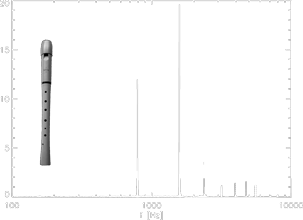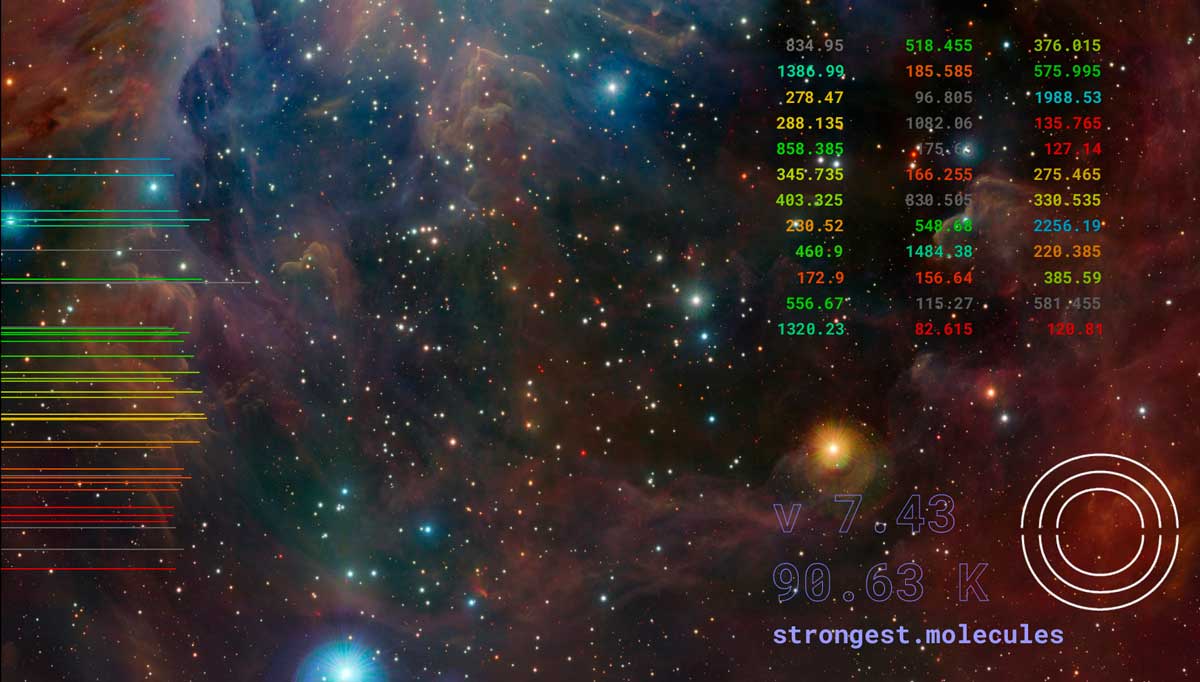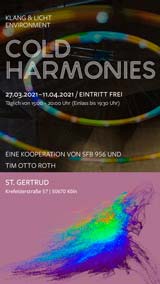 Sound and colour by physical excitation. If an object is made to vibrate by mechanical excitation, this can be acoustically noticeable. For example, if you pluck a taut string or blow a flute, the kinetic energy supplied is translated into vibrations that are audibly transmitted to the air as sound waves. Certain physical properties of the vibrating body become noticeable in the form of the composition of the sound. For example, a string vibrates in a certain fundamental tone depending on its tension and length, as well as in other overtones that have a certain "harmonic" or mathematical relationship to the fundamental tone (see diagram with the harmonics of a recorder).
Sound and colour by physical excitation. If an object is made to vibrate by mechanical excitation, this can be acoustically noticeable. For example, if you pluck a taut string or blow a flute, the kinetic energy supplied is translated into vibrations that are audibly transmitted to the air as sound waves. Certain physical properties of the vibrating body become noticeable in the form of the composition of the sound. For example, a string vibrates in a certain fundamental tone depending on its tension and length, as well as in other overtones that have a certain "harmonic" or mathematical relationship to the fundamental tone (see diagram with the harmonics of a recorder).
Objects can also be excited in other ways so that the energy supplied is translated into the form of light. If, for example, elements or molecules are stimulated to produce light, it can be observed that they emit light in characteristic colours. The wavelengths of the individual colours have a very characteristic relationship depending on physical parameters and the molecular structure. Due to an extreme slowing down from the speed of light to the speed of sound, the Cold Harmonies make this inherent harmonics audible and use it as a compositional source for the Orion Variations.
 The key to the conceptual understanding of the Cold Harmonies is the visualisation projected to the wall. In this projection a section moves through the optical image of the Orion nebula. The crosshairs in the centre indicate the respective location whose molecular radiation is translated into the sound event depending on the local temperature. The fact that it is extremely cold there can be seen from the temperature display at the bottom right, which shows the temperature in Kelvin. At Kelvin, abbreviated as K, the temperature count begins at absolute zero (minus 273 degrees Celsius). The value above it with the abbreviation v indicates the speed, how fast the gas masses are moving away from us in kilometres per second. Below the temperature is indicated which selection of molecules is currently being translated into sounds. These can be water(H2O),
ammonia(NH3), sulphur dioxide (SO2), oxygen (O), carbon (C) or three different isotopes of carbon monoxide
(12CO, 13CO or C18O). In three different modes, the molecules can also be experienced in unison: As a carbon monoxide isotope trio, with an equal distribution of six molecules, each playing on six speakers [even.six] or as a selection of the strongest emissions [strongest.molecules].
The key to the conceptual understanding of the Cold Harmonies is the visualisation projected to the wall. In this projection a section moves through the optical image of the Orion nebula. The crosshairs in the centre indicate the respective location whose molecular radiation is translated into the sound event depending on the local temperature. The fact that it is extremely cold there can be seen from the temperature display at the bottom right, which shows the temperature in Kelvin. At Kelvin, abbreviated as K, the temperature count begins at absolute zero (minus 273 degrees Celsius). The value above it with the abbreviation v indicates the speed, how fast the gas masses are moving away from us in kilometres per second. Below the temperature is indicated which selection of molecules is currently being translated into sounds. These can be water(H2O),
ammonia(NH3), sulphur dioxide (SO2), oxygen (O), carbon (C) or three different isotopes of carbon monoxide
(12CO, 13CO or C18O). In three different modes, the molecules can also be experienced in unison: As a carbon monoxide isotope trio, with an equal distribution of six molecules, each playing on six speakers [even.six] or as a selection of the strongest emissions [strongest.molecules].
Deceleration The 'light' emitted by the extremely cold molecules is not visible to the human eye. The frequencies of the observed electromagnetic radiation of the molecules are in the gigahertz range. To make them audible, they must be reduced to the hertz range and converted into sound. The deceleration factor, used in each case, which in a sense slows down the waves from the speed of light to the speed of sound, is indicated below the molecule display. It is important here that the frequency ratios remain untouched, i.e. that nothing changes in the inherent harmonics.
Scale as spectra The translated values are given as 36 frequencies in Hertz at the top right, representing the three horizontal speaker circles respectively in three columns. On the left margin of the picture, the frequencies appear as lines of a spectrum that extends from red at the bottom with the low tones to blue at the top with the high tones. In pulse mode, the frequency is also translated into different pulse lengths. This colour scale is also adopted for the table with the 36 frequency values and of course the corresponding speakers also light up in the respective colour. The intensity of the radiation is expressed on the one hand in the length of the lines or the brightness of the numerical value. If a frequency value is not played, the value and the corresponding line appear in grey. The speakers switch off the light when they are inactive.
Microtonal music of the spheres Even a glance at the spectral distribution of the individual tones makes it clear that the Cold Harmonies' inherent harmony is different from what we are used to in Western 12-tone music. What these microtonal scales have in common with the scale we are familiar with is that they are both conceptually linked back to the heavenly spheres. As Cologne musicologist Rainer Nonnenmann points out in his virtual introduction(Youtube) Western harmony goes back to the music of the spheres of the Pythagoreans, which describes musical intervals as ratios of whole numbers. The Cold Harmonies also pursue a cosmological connection by linking the idea of a celestial music of the spheres with the astrophysics of the 21st century.
In the Orion Variations, the listener embarks on a sonic journey through the Orion Nebula. Changing radiation intensities but also temperatures continuously change the structure of the molecular scales, whose tone sequences composer Tim Otto Roth varies even further by means of various procedures: the tone frequencies are distributed to the loudspeakers in different spatial arrangements - symbolised by three different graphic symbols at the bottom right. Lines and numerical values changing from grey to coloured further indicate that the tones are not necessarily all played at the same time, but that sound movements are created by deliberately switching them on and off, such as rotating or oscillating patterns. The three circular levels, each with 12 speakers, can be controlled separately in the metre and can also be varied rhythmically.
The Orion Variations were created in close collaboration with the astrophysicist Dr. Volker Ossenkopf-Okada from SFB 956 at the University of Cologne. The structure of the 1st Orion Variation is explained in more detail under the film documentation on the Vimeo page.
From March 27th to April 11th, the Cold Harmonies were on show in St. Gertrud, Cologne. The project Cold Harmonies were realized in the context of the outreach initiative of the DFG-funded Collaborative Research Centre SFB 956 Conditions and Effects of Star Formation at the Institute of Physics at the University of Cologne.


